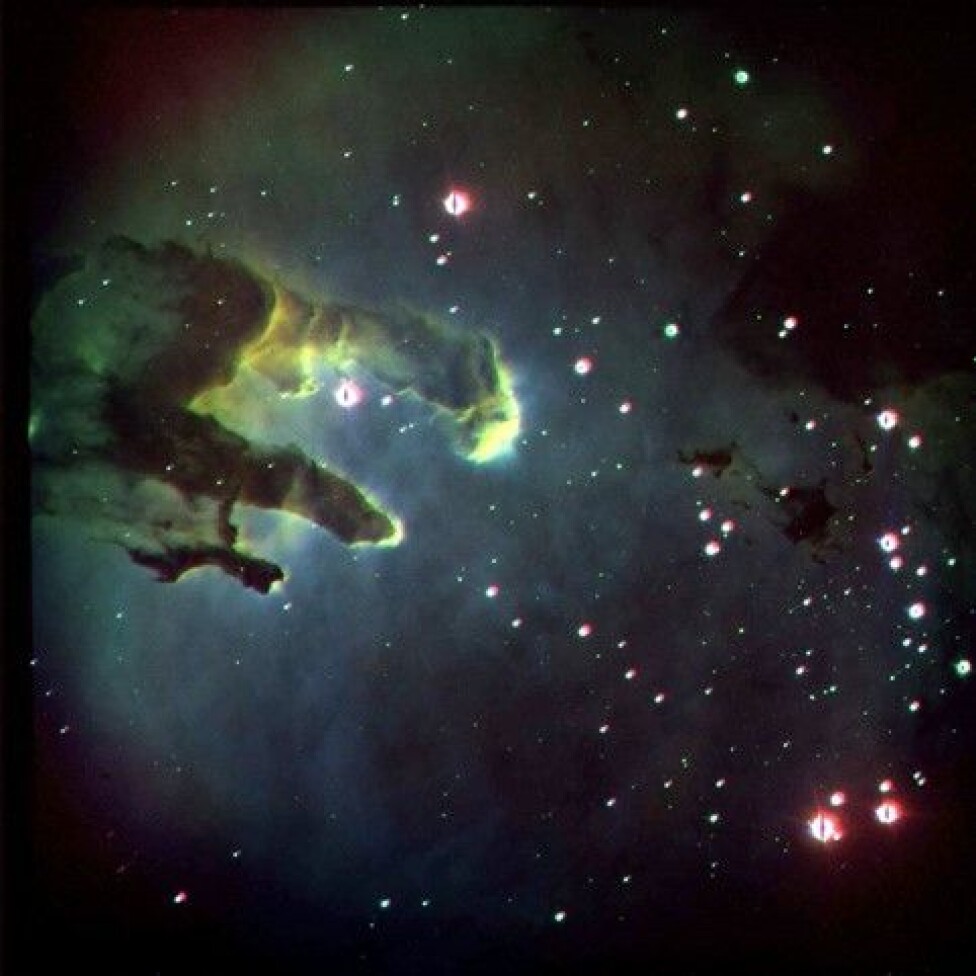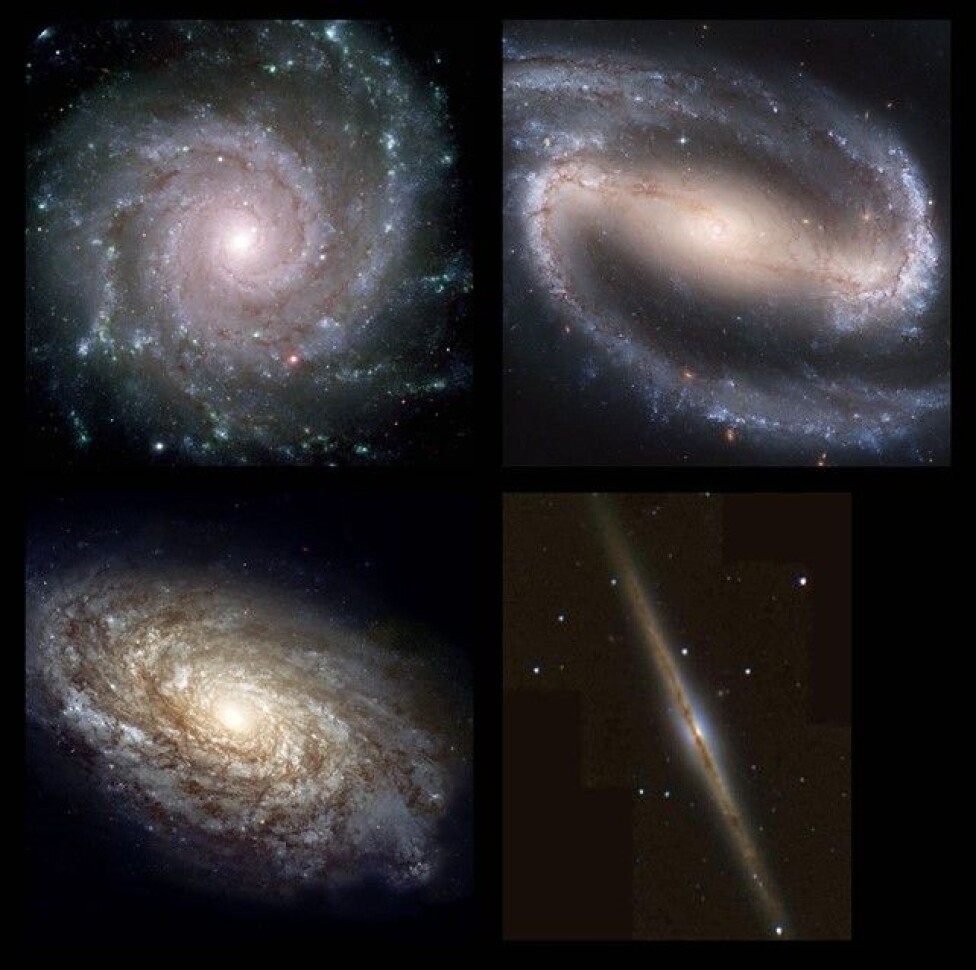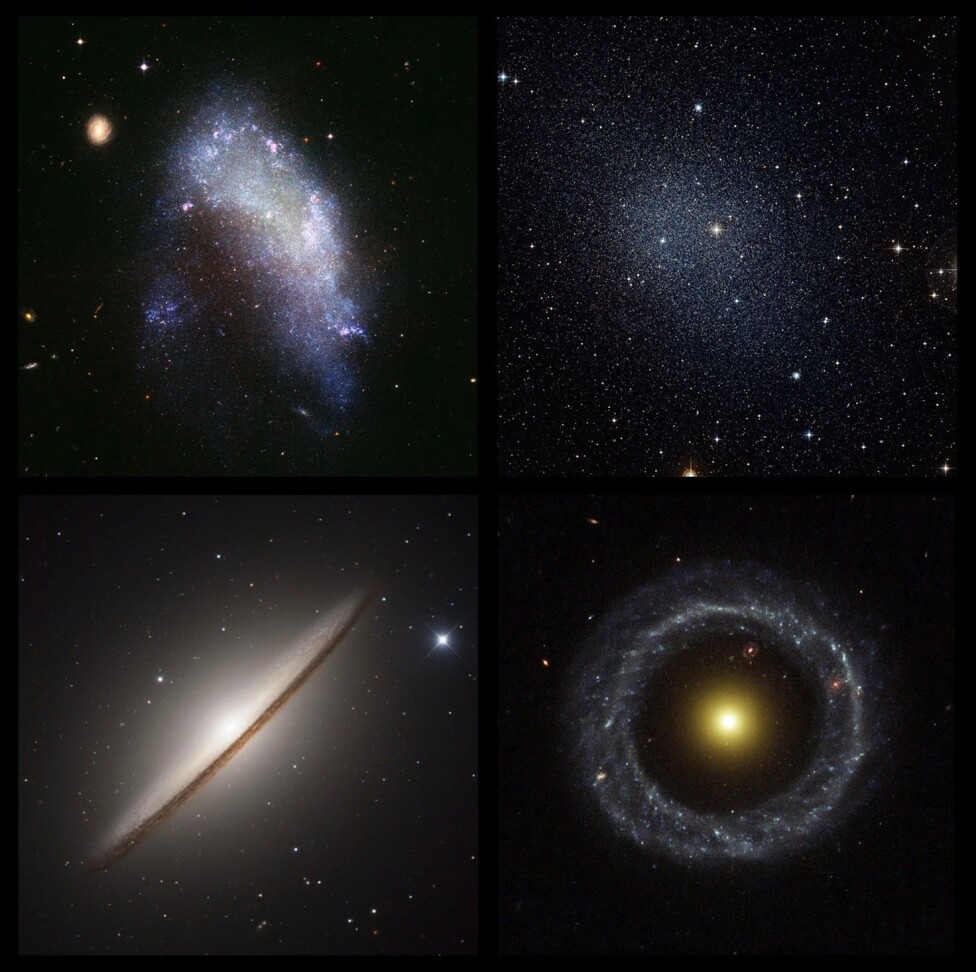Researchers' Zone:

What is a galaxy?
What are they made of and how many different types are there? Astrophysicist Peter Laursen explains.
Gazing at the dark night sky, you see stars scattered in all directions. There might be a few more here than there are there, but in general, the stars are distributed more or less evenly on the night sky.
However, if you find yourself in a particularly dark spot, you'll see a faint band of light across the sky. And if you were to point a telescope in the direction of this band, you'd see many many more stars.
Italian scientist Galileo Galilei was the first one to do this, thereby confirming the more than 2,000-year-old belief that the band, which for millennia had been called the 'Milky Way' from Greek galaxías kýklos, consisted of innumerable distant stars.
The idea started to form that the Solar System was located in a flattened clump of stars because looking along this 'disk' one sees an abundance of stars, while fewer are seen when looking away from the disk.
In addition to the stars, a number of fuzzy blobs were seen that were first thought to lie inside the Milky Way. People simply believed that the Milky Way was everything that existed — it was the entire Universe. However, the German philosopher Immanuel Kant proposed that the Milky Way merely was our Universe, while the fuzzy blobs — or nebulae — were distant 'island universes', far away from ours.
At this time, such thoughts were just speculations, but with the introduction of the camera and large telescopes, astronomers realized, just 100 years ago, that our galaxy — which the island universes are called today — is just one out of seemingly an infinite number of clumps of stars orbiting each other and held together by the force of gravity.
Whereas the distance between stars inside a galaxy is typically a few lightyears, distances between galaxies are measured in millions of lightyears. Between galaxies, there is basically nothing — around 1 atom per cubic meter.
The smallest galaxies host a few million stars, while the largest comprise trillions. The Milky Way, which can be considered a typical galaxy, contains a few hundred billion stars.
In this article, I’ll explain what a galaxy is, what it is made of, and which different kinds exist. In a subsequent ScienceNordic article, we will look into how the galaxies were created in the first place.
What are galaxies made of?
Five or six things can be pointed out as the building block of galaxies: stars, gas, dust, super-massive black holes, dark matter and, perhaps, planets.
Stars, as outlined above, are plentiful. Stars live for a long time, but not forever. As they exhaust their fuel and die, they leave behind white dwarves, neutron stars, or black holes.
But, although in general it is the stars that enable us to see the galaxies, they actually only account for a small fraction of the total mass of the galaxy.
Stars are made of gas, but between the stars — in the so-called interstellar medium — large amount of gas reside as well.
In small galaxies, there can be as much interstellar gas as star gas, while the fraction decreases with the size of the galaxy.
The interstellar medium is divided into different phases. Some regions are diffuse and extremely hot, with temperatures of millions of degrees. In these regions, the gas is ionized, meaning that most atoms have had one or more electrons ripped off due to the high temperature.
Other regions are denser and cooler, around 10,000 K.
The hotter the gas is, the higher the pressure, and the more it expands (this is the same mechanism that makes a hot air balloon rise).
Conversely, if the gas cools considerably (to around 100 degrees Kelvin, or –170 °C), very dense and cold molecular clouds are formed. This is where new stars are formed!
In the Big Bang, practically only hydrogen and helium atoms were created, which I wrote more about in the article The Big Bang — an eyewitness account.
But when stars burn out and die, they return part of their gas to the interstellar medium — only now it’s polluted with heavier elements (which astronomers affectionately generalize calling them all 'metals', though it might sound discordant to chemists).

Planets — a negligible fraction of the galaxy
When a star is born, a disk of gas and dust forms around it. Dust may clump together, forming rocks that in turn, make bigger rocks that can eventually end up as planets.
In the total mass budget, the planets play a diminishingly small role, but they are probably necessary for the existence of life, so they are quite exciting nonetheless.
Since the discovery of the first planets outside our Solar System a mere 25 years ago, it has become apparent that most stars have planets. We know now of more than 4,000 exoplanets (i.e. planets orbiting other stars than our Sun).
Supermassive black holes and dark matter
In the center of most galaxies resides a 'supermassive black hole'. These black holes can weigh millions or billions times the mass of the Sun (in astronomy everything is so massive that measuring stuff in grams or kilograms becomes impractical, so instead we use Solar masses, which is approximately the same as two billion billion trillion kilograms).
Gravity wise, their contribution is rather insignificant compared to the rest of the galaxy, but for a while, the black can generate an 'active galactic nucleus', or a quasar, which can blow out a substantial part of the galaxy’s matter from the galaxy.
Sometimes these quasars can evacuate the galaxy of gas to such an extent that it quenches the formation of new stars.
However, what we have heard of so far only makes up about 1/6 of the total mass. The majority of a galaxy’s mass is in fact something completely different, namely dark matter.
Dark matter differs from 'normal' matter in that it only interacts gravitationally. This means that it neither is affected by, nor exerts, electromagnetic or nuclear forces, so it cannot emit light, and it cannot collide with other things.
It is exactly because it doesn’t emit light that we call it dark matter. We cannot see it; we only see the effect it has on things that we can see, as it interacts gravitationally with the luminous matter.
The normal matter can cool and become a dense galaxy, but the dark matter has a harder time clumping together, and is therefore located in a much larger 'halo' around the visible part of the galaxy.
Thus, what we see as a galaxy is in fact but a fraction of what a galaxy actually is. This figure shows the approximate dimensions of the components of the Milky Way.

Galaxy zoo
Galaxies come in a variety of shapes and appearances, but in general, we can organize them into three classes:
- Spiral galaxies
- Elliptical galaxies
- Irregular galaxies
All of these classes have subgroups though, and some galaxies are even somewhat hors catégorie.
The appearance of a galaxy is called its morphology. If we want to study the evolution of galaxies, it is practical to classify them according to their type, but quite often, it is a bit subjective how you would classify a galaxy morphologically, since there are no clear boundaries between the different types.
If you want to help astronomers classify galaxies, you can visit galaxyzoo.org and help us decide.
As late as last year, results from this astro-crowdsourcing led astronomers to revise our understanding of how the arms of spiral galaxies behave (see this video for a review).
But let us take a closer look at the different types of galaxies.
The magnificent spiral galaxies
In my opinion, spiral galaxies are the most beautiful. Characterized by a reddish, central 'bulge' and a number of bluish spiral arms lying in a flat disk, they rotate majestically with periods of a few 100 million years.
The spiral arms only hold about 2-3 times as many stars as in between them, but since active star formation takes place in these regions, they are much brighter. Because the massive stars — which shine with a blue light but burn out fast —are still around here, the arms appear blue.
Around two-thirds of the spiral galaxies have a bar-like structure extending from the bulge. The bar is probably a kind of density wave, as are the spiral arms, capable of 'sucking in' gas from the surrounding spiral arms, which can then be used to from new stars.
This gas may also feed a supermassive black hole in the center of the galaxy, making it turn into an active galactic nucleus or a quasar.

Giants of the Universe: Elliptical Galaxies
Elliptical galaxies are, we believe, the result of the merging of many smaller (proto-) galaxies. During these collisions, the star formation rate first increases dramatically and we see one or several 'starbursts'.
The violent star formation can exhaust most of the gas in one go. The collision itself as well as stellar winds and supernovae blow out the rest of the gas, so that the formation of new stars becomes hard. Thus, only the old stars are left, and since old stars are red-orange, this is the color of most elliptical galaxies.
Hence, this so-called quenching leaves behind a red and 'dead' galaxy.
The largest galaxies in the Universe are elliptical, with masses of up to ten times that of the Milky Way. These galactic monsters often reside in the center of large galaxy clusters, i.e. collections of hundreds or thousands of galaxies, held together by gravity.

... and then there are all the other types of galaxies
Some galaxies, in particular the smaller ones, are neither elliptical nor disky, but have a completely different shape. These galaxies are called irregular galaxies.
The irregular shape is often due to collisions, or near-collisions, with other galaxies.
Irregular galaxies are typically small, since larger galaxies are better equipped to resist the shaking and stirring by other galaxies.
Another type is lenticular galaxies, a sort of combination between ellipticals and spirals: They exhibit some spiral structure, but also a clear elliptical halo.
The bigger and more massive a galaxy is, the less common it is. Most galaxies are thus dwarf galaxies, which can then be further categorized into dwarf spirals, dwarf ellipticals, dwarf irregulars, and dwarf spheroidal galaxies.
Ring galaxies have a bulge just as spiral galaxies, and a larger stellar ring structure. They might have formed by to another galaxy flying straight through a spiral galaxy, but they are very rare and thus not too well studied.
Recently, astronomers found the hitherto most distant of these strange galaxies with evidence of a cosmic 'hit-and-run' taking place 11 billion years ago.

How these enigmatic clumps of stars, gas, dust, and dark matter were created in the first place is a longer story, which you’ll be able to read more about in a follow-up article here on ScienceNordic.
Read the Danish version at Videnskab.dk's Forskerzonen. Thanks to Guarn Nissen for suggestions and edits during my translation of the text from Danish to English.
References
Peter Laursen's profile (Niels Bohr Institute, University of Copenhagen)
'Tracing the Stellar Mass in M51', Astrophysical Journal (1993), DOI: 10.1086/173376






